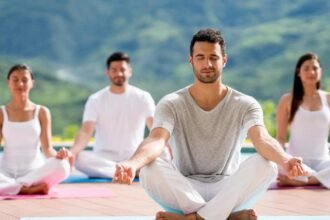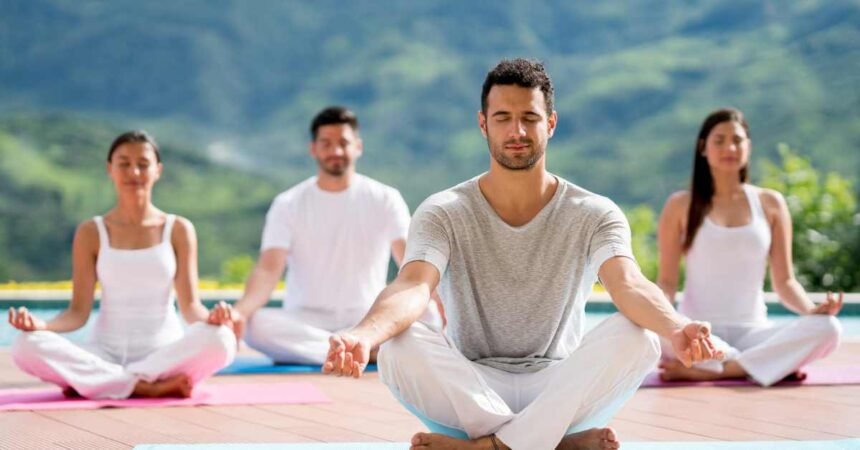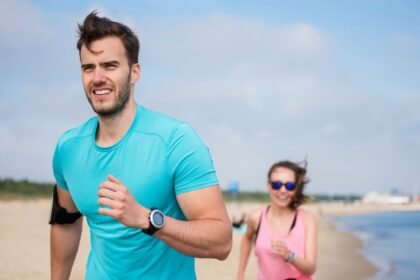Top Yoga Poses for Beginners to Boost Flexibility : When we first step onto our mats, excitement and uncertainty mix together. We often want to stretch further or bend deeper, but fear we can’t. It’s key to know that flexibility is a journey, not a requirement for starting yoga. Each pose we try helps us grow, both in flexibility and inner peace.
This article will show us the best yoga poses for beginners. These poses are easy to follow and help us relax. By practicing together, we can turn our stiffness into strength and freedom123.
Key Takeaways
- Flexibility is a journey cultivated through consistent practice.
- Beginner yoga poses are designed to enhance mobility and ease tension.
- Each pose provides unique benefits that contribute to overall well-being.
- Mindfulness and focus are essential in achieving optimal results.
- Holding poses for longer durations improves flexibility over time.
- The best yoga poses for beginners target areas like hamstrings, hips, and shoulders.
Understanding Flexibility and Its Importance
Flexibility is key to our physical health. It helps us move easily and lowers injury risks. Studies show that stretching boosts flexibility, making our joints more mobile4. As we age, our bodies lose moisture and elasticity, making us less flexible5. But, with regular stretching, we can fight this and keep our bodies working well.
Physical Benefits of Flexibility
Being flexible does more than just help us move. It also reduces muscle tightness and improves how we stand. Yoga for stiff bodies makes us more flexible, letting us move freely4. It also boosts blood flow to muscles, helping them work better4. Stretching lowers the chance of getting hurt, especially in key areas like our calves, thighs, and back4.
Mental Benefits of Improved Flexibility
Flexibility is good for our minds too. Yoga basics help reduce stress and make us feel better by easing tension. Regular stretching puts us in a relaxed, mindful state, which is key for feeling good overall. Yoga teaches us the value of flexibility, leading to a balanced mind and body.
How Yoga Enhances Flexibility
Yoga makes us more flexible by focusing on alignment, attention, and awareness. These are key for those who find yoga hard, as they help practice safely. By keeping the right posture, we get the most out of each pose. Gentle yoga teaches us to listen to our bodies, avoiding injuries and deepening our connection with our movements.
Alignment, Attention, and Awareness
Getting the alignment right is crucial when starting yoga. It makes the practice more effective and lowers injury risk. In poses like Downward-Facing Dog or Crescent Lunge, correct alignment boosts flexibility and stability. Paying attention helps us know our limits. This lets us improve slowly but surely.
Regular yoga can make us more flexible, especially in tight spots like the hamstrings and hips. Check out our discussion on key yoga poses here6.
Long-term Practice and Results
Yoga gets better with time. Regular practice makes us more flexible, and results vary from person to person7. Our body type, how often we practice, and how committed we are affects how we improve.
Doing poses like Reclined Hand to Big Toe Pose and Eye of the Needle Pose helps a lot. Being more flexible helps with better posture and less muscle strain. It also boosts our physical performance8. Yoga classes support us, using props when needed to help us get more flexible.
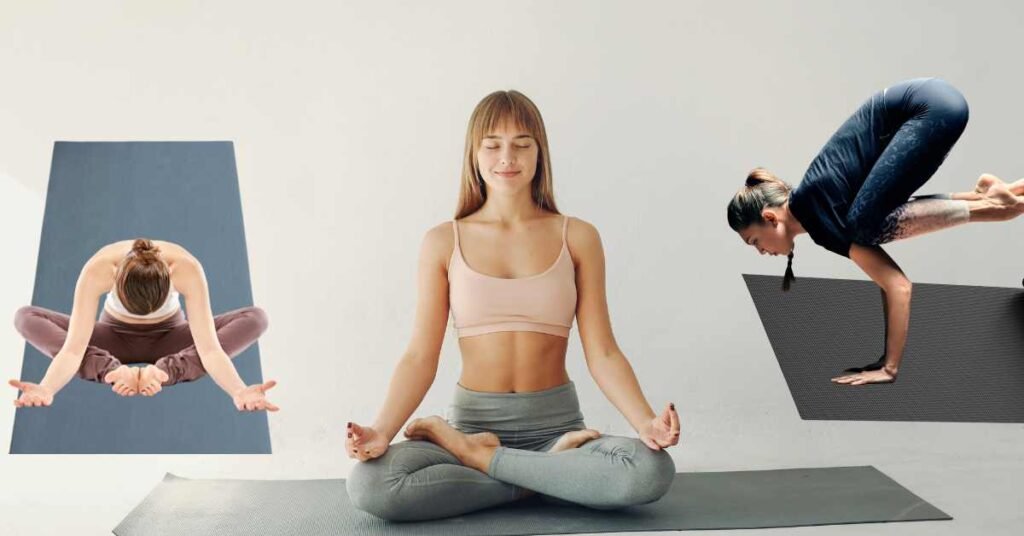
Top Yoga Poses for Beginners to Boost Flexibility
Starting our yoga journey can be exciting, but knowing the right poses is key. These poses focus on stretching key areas like the hamstrings, hips, and shoulders. These areas often get tight, so stretching them helps improve flexibility.
What Makes a Pose Effective?
A good yoga pose helps with alignment, balance, and awareness. It works the muscles and helps you breathe deeply to relax. Each pose in our routine helps make us more flexible.
- Alignment: Proper body alignment makes sure we get the most out of each pose.
- Breathwork: Deep breathing helps us stay focused and calm.
- Modifications: These poses offer changes for different flexibility levels, so everyone can join in safely.
Key Areas to Target: Hamstrings, Hips, and Shoulders
To increase flexibility, focus on specific muscle groups. Almost all basic yoga stretches target these key areas9. Working on the hamstrings, hips, and shoulders opens up our motion.
Adding these poses to our routine can really help with flexibility. Even just 10 minutes a day can make a big difference, as shown in a study in the Human Factors journal910.
| Body Area | Recommended Poses | Benefits |
| Hamstrings | Forward Fold, Downward Dog | Increases flexibility and reduces tightness |
| Hips | Pigeon Pose, Lizard Pose | Enhances mobility and relieves tension |
| Shoulders | Child’s Pose, Eagle Arms | Improves flexibility and decreases stiffness |
Getting Started with Beginner Yoga Poses
Creating a special space for yoga is key to a great experience. It should be calm, free from distractions, and well-ventilated. This setting helps us focus on the basics of yoga and enjoy our practice more.
Setting Up Your Practice Space
Here are some tips for setting up your yoga space:
- Choose a quiet room away from noise and interruptions.
- Ensure proper ventilation to keep the space fresh.
- Clear unnecessary items to create a clean, clutter-free environment.
- Use a comfortable mat to provide a supportive surface.
Choosing the Right Yoga Mat and Props
Choosing the right yoga mat is crucial, especially for beginners. A good mat offers grip, cushioning, and stability. Look for a mat that fits your needs in terms of thickness, material, and texture.
Using props like blocks and straps can help too. They support us in challenging poses, helping with flexibility1112. This can prevent injuries and help us progress in yoga. Aim for a daily 10-minute practice to see flexibility improvements11.
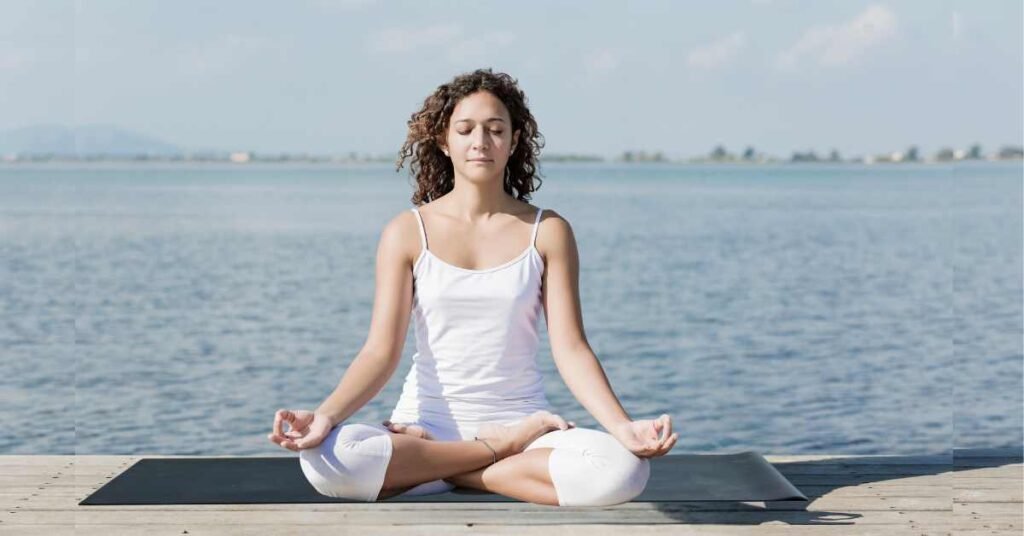
Essential Props to Enhance Flexibility
Using essential yoga props can really help us get more flexible. Things like yoga straps and blocks support our bodies in tough poses. They help us reach new levels of flexibility.
Using Yoga Straps
Using yoga straps is great for getting flexible. These straps come in different materials like hemp, cotton, or nylon. They can be up to 10 feet long13.
They help us stretch deeper and keep our bodies in line. This is especially useful in tough poses like Ardha badda padmottanasana and Ardha badda paschimottanasana14. Straps let us stretch past our limits, making our yoga better.
Incorporating Blocks for Support
Yoga blocks are also key for our practice. They come in materials like foam, rubber, cork, or wood13. These blocks help us adjust poses, making them easier for beginners who might struggle with balance or reach.
They let us safely do poses that work on hips, hamstrings, and shoulders15. If you don’t have blocks, you can use heavy books or firm pillows as substitutes13. This way, we don’t miss out on the benefits of stretching.
Reclined Hand to Big Toe Pose (Supta Padangusthasana)
Supta Padangusthasana, or the Reclined Hand to Big Toe Pose, is a key yoga pose for beginners. It stretches the hips, thighs, hamstrings, groins, and calves. This makes it great for our practice16. It also helps improve flexibility and muscle strength in the legs and lower body17.
Instructions and Benefits
To do Supta Padangusthasana, start by lying on your back with both legs out. Then, grab the big toe of one leg with your hand and lift it up. If it’s hard, using a strap can help keep you in the right position17. Hold the pose for five breaths on each side to stretch deeper with each breath16.
There are ways to make the pose better for you. You can press the heel of the bottom leg against a wall or use a block for support16. This helps keep you stable and focuses on stretching the backs of your legs, like the hamstrings and calves17.
Before doing Supta Padangusthasana, warm up with poses like Downward Facing Dog and Bound Angle Pose. These get your muscles ready for deeper stretches16. After, try standing poses and forward bends to get even more flexibility benefits16.

Eye of the Needle Pose (Sucirandhrasana)
The Eye of the Needle Pose, also known as Sucirandhrasana, stretches the hips and glutes. It helps relieve lower back stiffness, great for those who sit a lot18. We’ll guide you through the steps and offer modifications for different flexibility levels.
Instructions and Modifications
Start by lying on your back. Here’s how to do the pose:
- Begin by lying flat on your back.
- Bend your knees and place your feet flat on the floor.
- Cross your right ankle over your left knee, forming a figure four.
- Gently pull your left thigh toward your chest while keeping the right knee open.
- Hold the position for a few breaths, feeling the stretch in your hips.
- Switch legs and repeat.
If you’re not flexible enough, use a strap around your left thigh to help bring it closer. This keeps the pose right while giving you support.
Start with a 30-second hold and increase as you get more flexible. Practicing Sucirandhrasana regularly can improve hip and lower back health, important for a healthy life19.
Downward Facing Dog (Adho Mukha Svanasana)
Adho Mukha Svanasana, or Downward Facing Dog, is a key pose in yoga. It stretches the hamstrings, calves, and spine when done right. Getting the pose right helps improve our yoga practice.
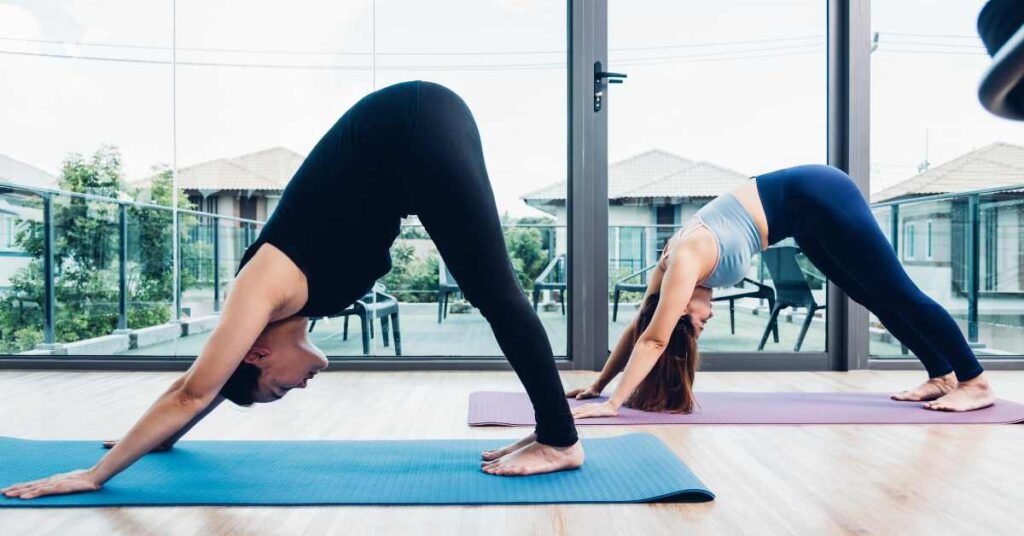
How to Properly Align
Start on your hands and knees for the right alignment. Make sure your wrists are under your shoulders and knees under your hips. Lift your hips up and back, keeping your spine straight for an inverted V shape. If it’s hard, bend your knees to ease tension and keep your back straight2021.
Engage muscles like quadriceps and triceps to build strength20. Keep your arms active and push your heels towards the ground for a better stretch21. If your back rounds, focus on opening your shoulders and adjust your hand and foot distance20.
There are modifications like Bent-Knee Downward Facing Dog and Downward Facing Dog Against a Wall for beginners21. These help make the pose effective and comfy, fitting our unique needs on our yoga path21.
Crescent Lunge (Anjaneyasana)
The Crescent Lunge, or Anjaneyasana, is a powerful pose that boosts flexibility and strength in the hips and legs. It’s great for beginners who want to work on balance and core strength. There are modifications for different skill levels, making it easy for everyone to join in.
Variations for Different Skill Levels
Crescent Lunge has many ways to practice, fitting all levels. Beginners start with the Low Lunge, focusing on keeping their body aligned and stable. Those more advanced can try a High Lunge or add deeper backbends and thigh stretches. Here are some ways to practice:
- Low Lunge: Great for those new to deep hip flexion.
- High Lunge: Works the core and is a bit harder.
- Quad Stretch Variation: Adds intensity for the thighs.
- Revolved Variation: Ideal for twisting in your practice.
Anjaneyasana stretches and strengthens the groins, hip flexors, and quadriceps. It also boosts core strength and balance2223. Be careful with this pose if you have heart issues or high blood pressure24. Using blocks or blankets can make the pose easier. If floor poses are tough, try doing it in a chair instead24.
To do Crescent Lunge right, focus on keeping your body aligned. Make sure the front knee is over the ankle and the hips are even22. Practicing regularly builds strength, balance, and grace, both in yoga and everyday life2223.

Pyramid Pose (Parsvottanasana)
Pyramid Pose, also known as Parsvottanasana, is great for improving flexibility and strength. It stretches the hamstrings and hips deeply, which is key for better flexibility. Practicing this pose helps us get stronger and keeps our body aligned to prevent injuries.
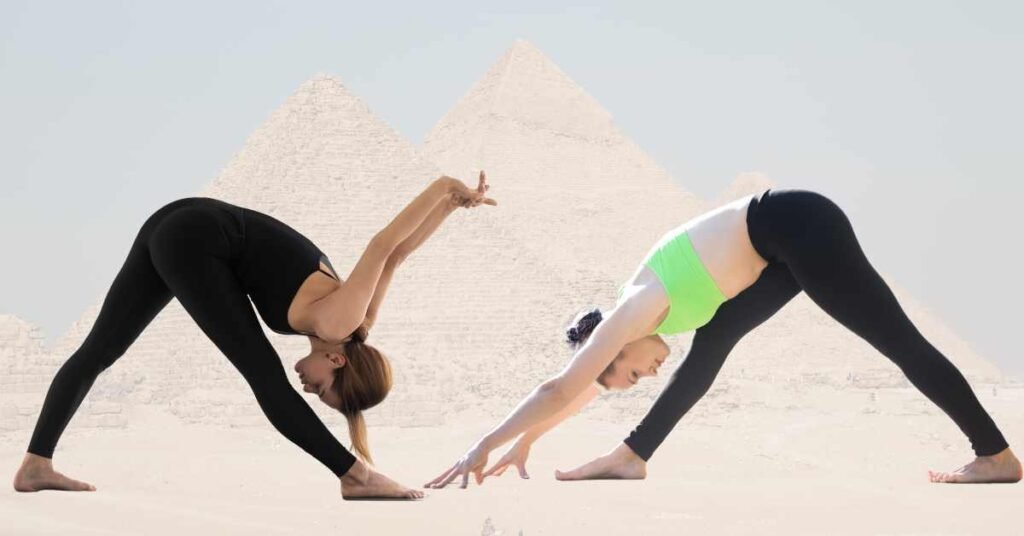
Deepening the Stretch and Alignment Tips
This pose stretches many parts of the body, like the hamstrings, shoulders, spine, chest, and hips. It makes us more balanced, coordinated, and improves our posture. It also calms the mind and helps with digestion25. Before doing Pyramid Pose, try poses like Seated Staff Pose, Locust Pose, and Shoulderstand25.
To start, stand with your feet apart and hips aligned. Reach back to clasp elbows or hands together. Breathe in and stretch your torso out, then breathe out and fold forward over the front leg, keeping your spine long25.
Beginners should hold the pose for 60 to 90 seconds on each side. Those more advanced can hold it for 2-5 minutes26. If you have injuries or find it hard to balance, try crossing your arms behind your waist or use blocks for support25.
It’s important to keep your hips squared and your torso long from the breastbone to the navel. Reach your head forward and your tailbone back25. Regular practice will improve your balance, leg strength, and mental focus25.
Common Mistakes Beginners Make
Starting yoga can be tough, and many beginners face challenges that slow their progress. It’s important to know and avoid these common mistakes for a safe and rewarding practice. Overstretching and not controlling your breath are two big mistakes that can really set you back.
Overstretching and its Risks
Many new yogis try to do too much, with 95% rushing to keep up with the experts27. This can lead to overstretching and injuries that might end your practice. Many beginners push past their limits, ignoring proper alignment, which 71% forget27.
Trying to do advanced poses too fast is another big problem, with 82% focusing on hard poses over basics, risking safety27. Not warming up properly also makes beginners prone to muscle strains and injuries28.
Neglecting Breath Control
Controlling your breath is key to getting the most out of yoga. Sadly, 87% of beginners hold their breath, which messes up the flow and hurts their performance2728. It’s important to remember that everyone is different, and comparing yourself to others can be discouraging, affecting 68% of beginners27.
Being mindful of your breath helps with movement and keeping your body in the right position. Not paying attention to this can cause discomfort and strain. So, making breath control a part of your routine is crucial for a better experience and staying injury-free.

Creating a Gentle Yoga Routine for Flexibility
Starting a gentle yoga routine can boost flexibility and improve both physical and mental health. We can make effective yoga sequences by picking poses that work on different muscles. This makes each session helpful and fun. Yoga makes us more flexible by slowly stretching out muscle fibers, making our movements easier and more comfortable29. Adding poses that work big muscles brings more blood flow, which makes our practice even better29.
Sequencing Poses for Best Results
A good routine has a mix of poses that flow smoothly into each other. It should focus on key areas like the hips, spine, and hamstrings. For example, Child’s Pose and Half Cobra stretch and strengthen these areas, helping with flexibility and joint health30. Here’s a simple gentle yoga sequence:
| Pose | Duration (minutes) | Target Areas |
| Knees to Chest | 2 | Lower back, hips |
| Half Cobra | 2 | Back, chest |
| Child’s Pose | 2 | Back, thighs |
| Spinal Flex | 1 | Spine, overall flexibility |
Time Commitment and Frequency
It’s best to practice our gentle yoga routines often to see real changes. Just 10 minutes a day can help reduce stress, better your posture, and boost energy29. Doing yoga two to three times a week lets us adjust based on our needs and schedules. The more we stick with it, the better our flexibility and health will get30.
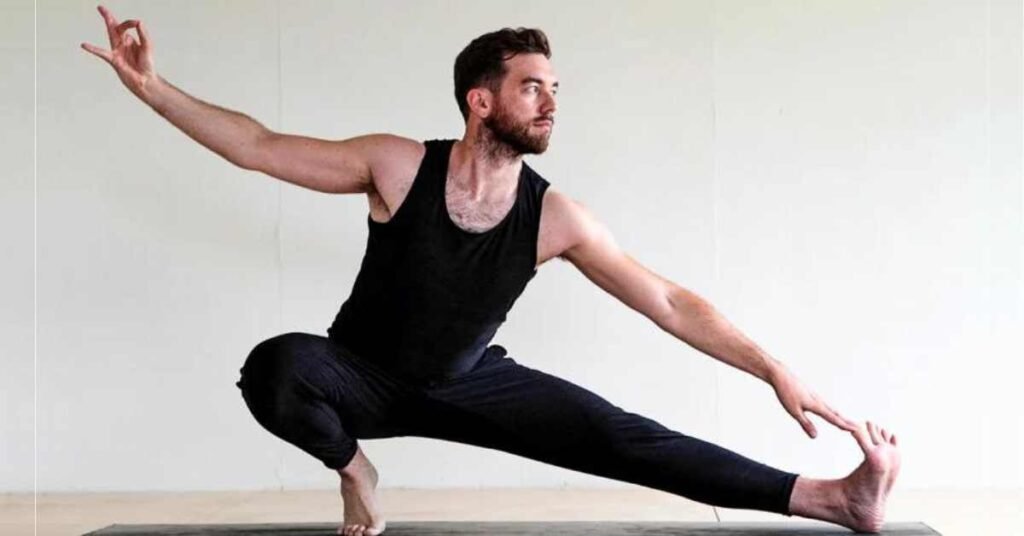
How Long to Expect Results?
Starting a yoga journey means understanding how long it takes to get flexible. Most people start seeing results in 3 to 6 months with regular practice31. Things like how often you practice, your age, and how consistent you are affect how fast you get flexible31.
It’s interesting to see how daily practice compares to practicing a few times a week. Studies show that just 10 minutes a day of yoga is better than a long session every now and then31.
Yoga comes in different styles like Yin, Vinyasa, and Hatha31. Each style has its own way of helping you get flexible. For example, Yin yoga makes you hold poses for 1 to 5 minutes, which stretches and releases tension32.
This shows us that breathing right helps our body open up and get more flexible. Longer holds in poses can also make us even more flexible32.
When it comes to yoga results, we should set realistic goals. Regular practice does more than just make you flexible. It also makes your bones stronger, improves your balance, and lowers stress31. So, whether you practice for 20 minutes a day or follow a different schedule, you can still reach your flexibility goals33.
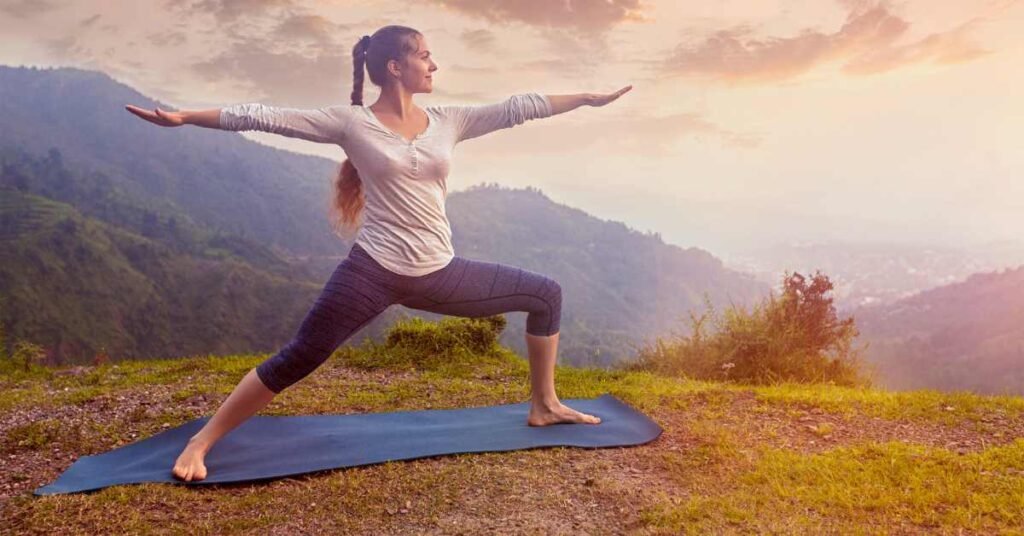
Conclusion
Reflecting on our journey through essential yoga poses shows us the many benefits of yoga. It helps improve our physical strength and mental health. By doing poses like Downward Facing Dog and Mountain Pose, we strengthen muscles and find calm and stability3435.
Yoga is easy for anyone to start, no matter their fitness level. We’ve seen how beginner-friendly poses can lead to positive changes with regular practice. This shows that flexibility is key to better health3635.
As we end our thoughts on yoga, let’s move forward with dedication and an open mind. Every yoga session helps us become more flexible and closer to our health goals. It also helps us connect deeply with ourselves and the practice34.
“For more health tips and to explore additional beginner-friendly yoga routines, visit our comprehensive guide at Health Point Plaza.”
FAQ
What are the best yoga poses for beginners to increase flexibility?
For beginners, great yoga poses include Downward Facing Dog, Reclined Hand to Big Toe Pose, and Eye of the Needle Pose. Crescent Lunge and Pyramid Pose are also excellent. These poses work on hamstrings, hips, and shoulders.
How often should beginners practice yoga to see flexibility improvements?
Beginners should aim for 2-3 yoga sessions a week. This consistency helps improve flexibility. Starting with gentle routines is a good idea for beginners.
Can yoga help improve flexibility for stiff bodies?
Yes, yoga is great for stiff bodies. It focuses on stretching and strengthening tight areas. Regular practice loosens muscles and boosts flexibility.
What type of yoga mat is best for beginners focusing on flexibility?
Choose a yoga mat with good grip and cushioning for comfort and stability. A thicker mat supports joints during poses, helping beginners.
Are yoga props really necessary for improving flexibility?
Yoga props like straps and blocks are optional but helpful. They make poses safer and more accessible for beginners. They support and improve alignment.
What should I be aware of when practicing yoga to avoid injuries?
Pay attention to your body’s signals and avoid overstretching. Focus on proper alignment and mindful breathing. These steps help prevent injuries.
How long will it take to see results in my flexibility from yoga?
Results differ for everyone, but consistent practice helps many see flexibility gains in weeks. Being patient and open-minded is important.
How can I create a gentle yoga routine to improve my flexibility?
Start with poses that target tight areas in a careful sequence. Aim for 20-30 minutes of practice, focusing on breath and relaxation.
What are some common mistakes beginners make in yoga?
Common errors include overstretching, ignoring breath, and rushing poses. Listen to your body and take your time for a safe practice.
Source Links
- The Best Yoga Poses for Flexibility – https://www.yogajournal.com/poses/yoga-by-benefit/flexibility/
- 20 Beginner Yoga Poses for Flexibility (+ free printable) – https://yogarove.com/beginner-yoga-poses-for-flexibility/
- Yoga for Flexibility: A Starter Guide – https://greatist.com/fitness/yoga-for-flexibility
- Stretching is not a warm up! Find out why – https://www.mayoclinic.org/healthy-lifestyle/fitness/in-depth/stretching/art-20047931
- What Every Yogi Needs to Know About Flexibility – https://www.yogajournal.com/practice/beginners/what-science-can-teach-us-about-flexibility/
- Yoga For Flexibility: 9 Best Yoga Poses To Become More Flexible | LiForme – https://liforme.com/blogs/blog/yoga-for-flexibility
- Yoga for Flexibility: 8 Poses for Your Back, Core, Hips, Shoulders – https://www.healthline.com/health/exercise-fitness/yoga-for-flexibility
- Impact of 10-weeks of yoga practice on flexibility and balance of college athletes – https://www.ncbi.nlm.nih.gov/pmc/articles/PMC4728955/
- 10 yoga stretches for beginners that will boost flexibility – https://www.fitandwell.com/how-to/yoga-stretches-for-beginners
- You Should Hold These Yoga Stretches For 30 Seconds—Here’s Why – https://www.womenshealthmag.com/fitness/g31143417/yoga-stretches/
- 10 Minute Beginner Yoga Routine for Flexibility (+ Free PDF) – https://yogarove.com/beginner-yoga-routine-for-flexibility/
- 30 Day Yoga Flexibility Series for Beginners | Yoga With Bird – https://yogawithbird.com/2020/09/12/30-day-yoga-flexibility-series-for-beginners-inflexible-people/
- Essential Yoga Props To Make Your Sessions Better – https://health.clevelandclinic.org/yoga-props
- Essential Yoga Props for beginners to improve their practice – https://www.kushiyogalaya.com/post/essential-yoga-props-for-beginners-to-improve-their-practice
- The Best Yoga Poses for Flexibility – https://www.bodhisurfyoga.com/yoga-for-flexibility
- Reclining Hand-to-Big-Toe Pose I – https://www.yogajournal.com/poses/reclining-big-toe-pose/
- How to Do Reclined Big Toe Pose (Supta Padangusthasana) – https://liforme.com/blogs/blog/how-to-do-reclined-big-toe-pose-supta-padangusthasana
- 9 Yoga Poses to Improve Your Flexibility — Rivers Fitness – https://www.riversfitness.co.uk/blog/9-yoga-poses-to-improve-your-flexibility
- The 5 Best Yoga Poses for Improving Your Flexibility – https://www.agniyogaindia.com/yoga-poses-for-improving-flexibility
- Downward-Facing Dog Pose – https://www.yogajournal.com/poses/downward-facing-dog/
- Downward Facing Dog for Beginners: 5 Ways to Practice – https://yogauonline.com/yoga-practice-teaching-tips/yoga-for-beginners/downward-facing-dog-for-beginners-5-ways-to-practice/
- How to Do Crescent Lunge in Yoga – https://www.everydayyoga.com/blogs/guides/how-to-do-crescent-lunge-in-yoga?srsltid=AfmBOor-vjCy_WI6wNg37lNSyWFSr8ZTniYpNZKeRhKuJpFBKTAdfPYz
- How To Do Low Crescent Lunge Pose (Anjaneyasana) | Liforme – https://liforme.com/blogs/blog/low-crescent-lunge-pose
- Low Lunge – https://www.yogajournal.com/poses/low-lunge/
- How to Do Pyramid Pose in Yoga – https://www.everydayyoga.com/blogs/guides/how-to-do-pyramid-pose-in-yoga?srsltid=AfmBOoor7JRdiX8pib-vVtXK10STH04Kc9j60YXARQEWxLbylJWXMTht
- Parshvottanasana (Intense Side Stretch Pose) – https://myyogateacher.com/yoga-asana/parshvottanasana
- 8 Common Beginner Yoga Mistakes and How to Avoid Them – – https://vimfitness.com/8-common-beginner-yoga-mistakes-and-how-to-avoid-them/
- 10 Common Mistakes Beginners Make in Yoga and How to Avoid Them – https://www.pracheenyoga.com/post/10-common-mistakes-beginners-make-in-yoga-and-how-to-avoid-them
- Morning Yoga Stretches: 12 Poses in 10 Minutes – https://www.sleep.com/sleep-health/morning-yoga-stretches
- 5 Gentle Yoga Poses to Help You Relax and Unwind – https://www.onepeloton.com/blog/gentle-yoga/
- How Long Does it Take To Gain Flexibility with Yoga? – https://yogarove.com/time-to-gain-flexibility-with-yoga/
- How Long To Hold Yoga Poses: A Guide – https://manflowyoga.com/blog/how-long-to-hold-yoga-poses-a-guide/
- 20 Minute Yoga for Beginners- Is a 20 Minute Practice Enough Time to Do Yoga? – Body By Yoga – https://bodybyyoga.training/yoga-for-beginners/20-minute-yoga-for-beginners/
- Top 10 Yoga Poses for Beginners: A Guide to Get Started – https://www.allyogatraining.com/top-10-yoga-poses-for-beginners/
- Top 10 Yoga Poses to Stay Healthy and Flexible – https://www.granimals.com/blogs/top-10-yoga-poses-to-stay-healthy-and-flexible
- Best Yoga Poses For Beginners – https://www.corkyogis.com/blog/best-yoga-poses-for-beginners?srsltid=AfmBOor6iU3qkJ9gIvIyceXBtpfFkWxkuzZu-ebxhBY3ScfNw4x9UdrF




